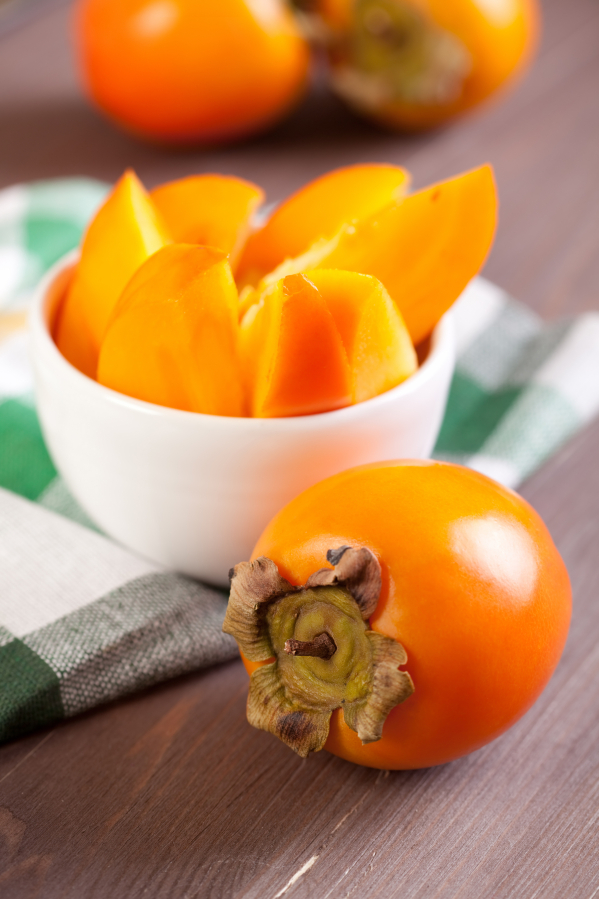Persimmons are not the most common fruit found in American homes, but they can be quite delightful. Local persimmons appear in markets in September through December, giving time to feast on this luscious fruit.
Native to Asia, persimmon seeds first came to the United States when Commodore Perry sent them from Japan in 1856. The Greek botanical name, Diospyros, translates to “Food of the gods.”
There are two types of persimmons, astringent and non-astringent, with many varieties of each. The Hachiya variety is sweet and squishy when ripe. They are an astringent variety and can be bitter if eaten unripe. The fruit is reddish-orange and heart shaped. The Fuyu variety, non-astringent, looks like an orange tomato and is eaten when it is firm.
Persimmons average 75 calories each. They are a good source of dietary fiber, antioxidants, Vitamins A, B complex and C, and healthy amounts of minerals.
Ripe persimmons can be eaten out of your hand. Fuyus for example are eaten whole like an apple. The Hachiyas variety are usually scooped out with a spoon. Fresh persimmons add flavor and color to green salads and fruit salads, and top yogurt or ice cream.
Chop the sweet fruit to make a salsa with the addition of red onion, cilantro and chili peppers. Chill to blend flavors, and store in the refrigerator for up to a week.
Fish, poultry or pork turns gourmet when paired with a simple chutney made of one pound of ripe persimmons. Bring to a boil 1 cup of balsamic vinegar, 1/4 cup diced red onion, 1 tablespoon of fresh grated ginger and a dash of chili flakes, add the chopped persimmons and simmer for five minutes, stirring to prevent burning. Chill and store covered in refrigerator for up to a month.
Persimmon recipes abound, especially for desserts such as pies, cookies, cakes, puddings and bread. For a dip for fruit or crackers, stir persimmon puree into cream cheese; add a dash of orange juice, honey and a pinch of salt.
Dehydrated persimmons make a sweet portable snack and can be stored in a tightly covered container for up to 8 months. Rinse and dry the fruit, cut off the cap end and slice into 1/4 – or 1/2 -inch rounds. Place in a single layer on dehydrator tray and dry at 115 degrees. Check the slices to see if done at 24 hours. The dried fruit should be pliable and leather-like.
Persimmons can be frozen whole for addition to cooked recipes, or peeled and pureed with the addition of ascorbic acid or lemon juice to keep the color fresh. Pack sweetened or unsweetened puree into freezer containers, leaving space for expansion.
The WSU Extension website provides free, downloadable information and resources outlining safe and proven methods for dehydrating (PNW397), canning fruit (PNW0199) and freezing fruit (PNW0214) in addition to other preservation and food safety topics.
For additional recipes and serving suggestions, check out Chef Scotty’s Market Fresh Recipes at ext100.wsu.edu/clark/?p=8163.
Judi Seifert is a Clark County WSU Extension Master Food Preserver. For additional recipes, food preservation and food safety information visit ext100.wsu.edu/clark/?p=1134. Have questions? Call MFP Helpline: 360-397-6060 ext. 5366, or join Facebook Discussion Group “WSU Home Food Preservers – Clark County.”



